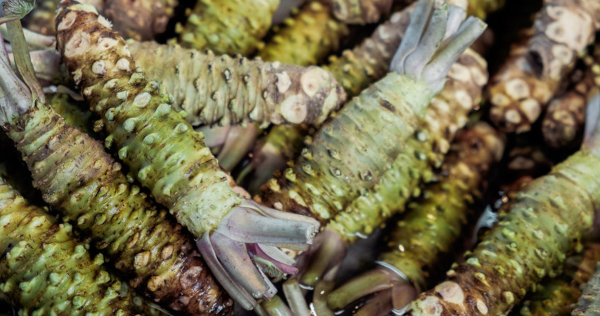.jpg.aspx?width=360&height=240&resizemode=force)
Why Wasabi Is Good for More Than Just Sushi
There's more to wasabi -- or Japanese horseradish -- than being the best condiment for sushi. Scientifically known as Wasabia japonica (Miq.) Matsum, this perennial plant native to Japan has been cultivated for over a thousand years.[i] It is now grown in other countries as the interest in Japanese cuisine grows.
Wasabi, most well-known for its sharp, pungent flavor and vibrant green color, is a cruciferous vegetable that grows along streambeds in Japan's mountain river valleys as well as in parts of China, New Zealand, North America and Korea.
Isothiocyanates (ITCs), which give wasabi its strong smell and unique flavor, provide a number of health benefits.[ii] It's worth noting, however, that ITCs are toxic at high intakes. Let's have a closer look at what wasabi has to offer for health and wellbeing.
Wasabi's Antibacterial Effects
A 2008 study assessed the antibacterial activity of Korean and Japanese wasabi roots, stems and leaves against Helicobacter pylori.[iii] The various wasabi parts, where the allyl isothiocyanate (AIT) were extracted from, all showed antibacterial activities against strains NCTC 11637, YS 27 and YS 50, with the leaves showing the highest desired action.
Other studies concluded that wasabi leaves and AIT may offer a natural remedy for stomach lesions caused by H. pylori.[iv]
H. pylori is a common bacterium infecting the stomach as well as the small intestine. It is the primary culprit behind peptic ulcers and can induce inflammation of the stomach lining and stomach cancer.[v] Socioeconomic conditions, sanitation and the level of urbanization likely affect the difference between H. pylori from one country to another.
Wasabi May Fight Pancreatic Cancer
In a 2014 study published in the journal Evidence-Based Complementary and Alternative Medicine, wasabi was found to potentially help fight highly lethal pancreatic cancer by tackling the root cause of malignancy along with its resistance to conventional treatment.[vi]
The Taiwanese researchers studied compound 6-(methylsulfinyl)hexyl isothiocyanate (6-MITC), a naturally occurring wasabi isolate, and its two synthetic derivatives I7447 and I7557, on human pancreatic cancer cells. They used human pancreatic cancer cells PANC-1 and PxPC-3 to perform an MTT assay for cell viability (to measure the number of viable cells present) and Liu's stain for morphological observation (changes in cell shape).
The findings showed that wasabi-derived compounds demonstrated several anticancer effects, including inhibiting the viability of PANC-1 and BxPC-3 cells and showing cell division arrest and apoptosis, or programmed cell death, in morphological observation.
"In conclusion, wasabi compounds 6-MITC and I7557 may possess activity against the growth and CSC phenotypes of human pancreatic cancer cells," the researchers wrote.
Pancreatic cancer is becoming more difficult to treat via conventional methods, remaining the leading cause of cancer death worldwide and characterized by rapid progression, highly invasive tumors and resistance to chemotherapy.[vii] Prognosis is extremely grim at a 10% one-year survival rate and 5% chance of surviving beyond five years, making potential treatments a priority.
Help for Atopic Dermatitis
A team investigated the effects of wasabi rhizome extract on atopic dermatitis in animal models, feeding wasabi extract to hairless subjects with dermatitis symptoms.[viii]
In the trial, the wasabi rhizome-containing special diet (5% and 10%) reduced the scratching behavior, while the 10% diet significantly reduced the behavior on the 28th, 35th and 42nd days. The results suggested that the extract improved the atopic dermatitis-like symptoms in the subjects.
Wasabi May Enhance Brain Health
ITCs in wasabi may offer neuroprotective benefits. In one study, AIT had promising anti-neuroinflammatory effects on microglial cells, which may lend significant insight into neurodegeneration.[ix]
A separate study focused on wasabi's neuritogenic-promoting activity, indicating a potential therapeutic role in neurological conditions.[x] In their extensive screening, the team found that Japanese horseradish is the richest source of 6-HITC among Brassica vegetable extracts studied. 6-HITC is an analogue of sulforaphane isolated from broccoli, deemed one of the major neuritogenic enhancers in wasabi.
These findings emphasize wasabi components' potential to help prevent or slow neurodegenerative diseases rooted in inflammation, including Parkinson's disease.[xi]
Real Versus Fake Wasabi
If you are keen on incorporating wasabi into your diet, you may combine it with soy sauce to be enjoyed with sushi or add it to your favorite noodles. Wasabi can also be used as a condiment for meats, roasted vegetables and a variety of grilled dishes.
Beware, however, that the vast majority of wasabi out there is a mix of horseradish, hot mustard and green dye.[xii] In fact, an overwhelming 99% of wasabi sold in the U.S. may be fake.
Real wasabi is expensive and much less common because of the difficulty of growing it. At any rate, genuine wasabi in powder, paste and fresh forms can be bought online from high-quality sources. Discover more wasabi research on GreenMedInfo.com.
© [11/30/2021] GreenMedInfo LLC. This work is reproduced and distributed with the permission of GreenMedInfo LLC.

